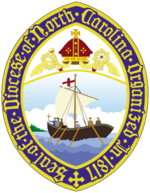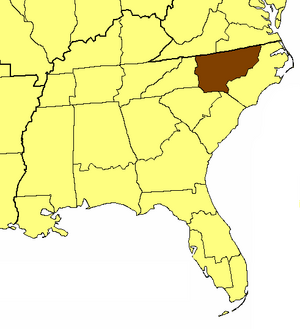Episcopal Diocese of North Carolina facts for kids
Quick facts for kids Diocese of North Carolina |
|
|---|---|
 |
|
| Location | |
| Country | United States |
| Ecclesiastical province | Province IV |
| Statistics | |
| Congregations | 109 (2021) |
| Members | 44,695 (2021) |
| Information | |
| Denomination | Episcopal Church |
| Established | April 24, 1817 |
| Current leadership | |
| Bishop | Samuel Sewall Rodman III |
| Suffragan | Anne Hodges-Copple |
| Map | |
 Location of the Diocese of North Carolina |
|
| Website | |
| www.episdionc.org | |
The Episcopal Diocese of North Carolina is a special church district for the Episcopal Church in the central part of North Carolina. It's part of a larger group called Province IV. This diocese was started a long time ago, in 1817.
Today, its area covers the middle section of North Carolina, roughly between the I-77 highway in the west and the I-95 highway in the east. This area includes some of the biggest cities in the state, like Raleigh, Charlotte, Winston-Salem, Greensboro, and Durham. When it first began, the diocese covered the entire state. But over time, two new dioceses were created: the Diocese of East Carolina in 1883 (which goes to the coast) and the Diocese of Western North Carolina in 1922 (which covers the mountains).
Contents
About the Diocese
Even though it's a big church district, the Diocese of North Carolina doesn't have one main cathedral building. Its main offices are located in Raleigh, which is the state capital.
Representatives from the diocese's 109 churches meet once a year in November. This meeting is called a diocesan convention. When the convention isn't happening, a group called the Diocesan Council helps run things. They work with the diocese's staff, who are led by the bishop.
Who Leads the Diocese?
The main leader of the diocese is called the diocesan bishop. The current bishop is Samuel Sewall Rodman III. He became the twelfth bishop of the Diocese of North Carolina on July 15, 2017. Before him, Michael Bruce Curry was the bishop, but he was chosen to be the Presiding Bishop of the Episcopal Church, which is the top leader for the entire Episcopal Church in the United States.
The diocese also has an assistant bishop, Jennifer Brooke-Davidson. Another important leader, Bishop Anne Hodges-Copple, who was a bishop suffragan (a bishop who helps the main bishop), retired in December 2022. She was the first woman to serve as a bishop in this diocese.
What the Diocese Believes and Does
The churches within the diocese have different styles, from more traditional to more modern. However, the diocese as a whole is seen as moderate and strongly supports the wider Episcopal Church.
There are about 48,000 members in the diocese, making it the tenth-largest Episcopal diocese in the United States. It has been growing steadily over the last ten years. The most Episcopalians live in Wake County, where Raleigh is located.
Programs and Community Work
The diocese runs several important programs, especially for students and for helping people in the community.
- Campus Ministry: They have programs for college students at many universities, including North Carolina State University, St. Augustine's University, Duke University, Elon University, the University of North Carolina at Chapel Hill, the University of North Carolina at Greensboro, the University of North Carolina at Charlotte, Wake Forest University, and Davidson College. In 2019, they even launched a smartphone app called YEAH (Young Episcopal Adult Hub) for young adults.
- Social Ministry: The diocese is very involved in helping people. One important project is the Episcopal Farmworkers Ministry in Newton Grove. This is a joint effort with the Diocese of East Carolina. North Carolina has a growing Latino population, so the diocese also has a special committee to support Hispanic Ministry. This group helps churches serve Latino communities, provides resources, and speaks up for the rights of migrant workers and for fair immigration laws.
The diocese used to have a camp and conference center, but they sold it to the state of North Carolina. It is now Haw River State Park. However, the diocese still has active programs for young people.
Several independent schools in the diocese have connections to the Episcopal Church. These include Trinity Episcopal School and Palisades Episcopal School in Charlotte, Canterbury School in Greensboro, and St. Mary's School, St. Timothy's School, St. David's School, and Ravenscroft School in Raleigh.
Other important organizations connected to the diocese are Penick Village in Southern Pines, which is a retirement community, and Thompson Child and Family Focus in Charlotte, which helps young people and families.
A long time ago, the diocese also ran two hospitals in Charlotte, St. Peter's Hospital and Good Samaritan Hospital. These were started by Jane Renwick Smedburg Wilkes, who was a leader in the Diocese's Women's Aid Society.
Bishops of the Diocese
The Diocese of North Carolina has had many bishops since it was founded. Here are the main bishops who have led the diocese:
- John Stark Ravenscroft (1823–1830) – The first bishop.
- Levi Silliman Ives (1831–1852)
- Thomas Atkinson (1853–1881)
- Theodore B. Lyman (1881–1893)
- Joseph Blount Cheshire (1893–1932)
- Edwin Anderson Penick (1932–1959)
- Richard Henry Baker (1959–1965)
- Thomas Fraser (1965–1983)
- Robert Whitridge Estill (1983–1994)
- Robert C. Johnson Jr. (1994–2000)
- Michael Bruce Curry (2000–2015) – He later became the Presiding Bishop of the entire Episcopal Church.
- Samuel S. Rodman, III (2017–Present) – The current bishop.
The diocese has also had other bishops who helped the main bishop, like assistant bishops and bishops suffragan. One notable helping bishop was Henry Beard Delany, who was the first bishop suffragan of North Carolina (1918–1928).

